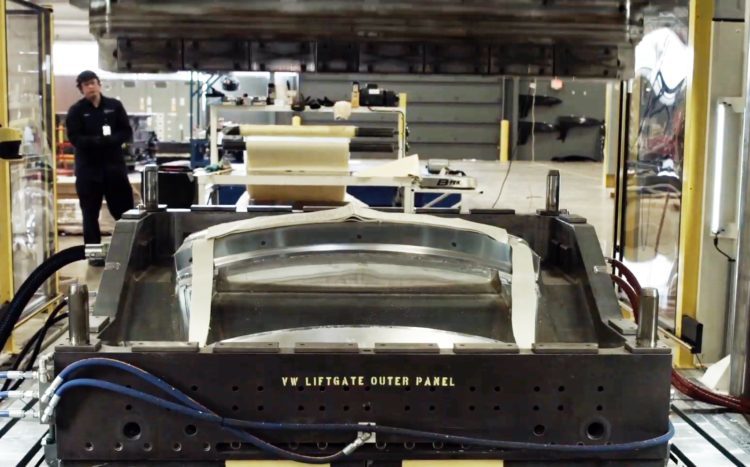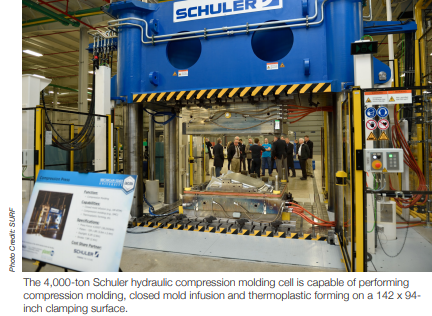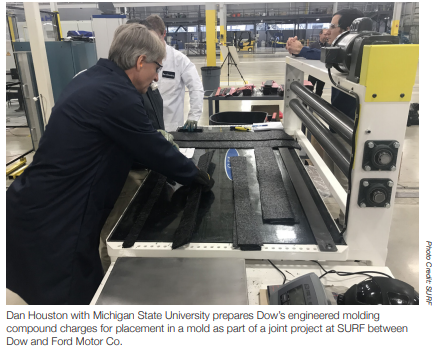

The Technology Behind Bigger Innovation
When chemical company BASF’s Performance Materials division wanted to develop a prototype for a new part over 10 feet in size, it knew compression molding would be the ideal production method. A compression molding press has the potential to support a fully-automated manufacturing process within a customer’s plant. But BASF pondered how to get an entirely new component ready for full-scale testing and validation without a customer risking the expense of an unproven technology.
“We first approached this as chemists. We have extensive knowledge about process and application, but making prototypes this big presented issues,” explains Staci Wegener, market segment manager of infrastructure at BASF Corporation. Wegener isn’t able to reveal too many details about the unique part under development, but did share that its size would have been a hindrance without the support of IACMI – The Composites Institute’s Scale-Up Research Facility (SURF) in Detroit, which conducts research and development on lightweighting vehicle structures and is managed by Michigan State University (MSU).
“We explored other options where we could make a prototype, but the size of the press that SURF has in their facility is really unique,” says Wegener. “I don’t think there are too many presses of that size available for this sort of application.”
The machine Wegener is referring to is a 4,000-ton hydraulic compression molding press from Schuler, which can perform closed mold infusion and thermoplastic forming in addition to compression molding. The press employs four double-acting cylinders to provide greater parallelism control for improved surface features, helping to ensure high-quality manufactured parts. Equally as important for BASF’s application, the press features a clamping surface of 142 x 94 inches and a daylight of over 8 feet for larger applications.
“SURF is helping us scale up from lab-scale-size parts to full-scale prototypes without us investing millions of dollars investment into true technology production equipment,” says Wegener. “This will speed up the path to commercialization.”
Filling a Gap
The 50,000-square-foot SURF is the only facility of its kind in the United States, and the team behind it has worked to quickly establish an operation that can match the decades of production experience behind overseas research centers. The vision for an innovation center of this type in the U.S. has been around since at least the early 2000s, when automotive industry researchers began looking for space to work on full-scale product development and testing. With support from the U.S. Department of Energy Advanced Manufacturing and Vehicle Technologies Offices, the Michigan Economic Development Corp. and a number of industry partners, SURF was born and research officially began in 2016.
“We were trying to fill a gap when we created the vision,” says Ray Boeman, director for IACMI Vehicles Scale-Up Facility and a professor at MSU. “Companies could do basic research at universities or national laboratories with non-production scale equipment. But if you're a material provider, you're developing material you want to sell to an OEM, and you want to take them a full-scale part.” Having a facility where companies can innovate before investing in expensive capital for development allows for greater freedom in innovation and helps OEMs make more informed commercialization decisions.
The facility offers a range of manufacturing technologies, which companies find bridge the gap between research and commercialization. The ability of the compression press to achieve high-volume production levels and ensure strong thermal stability for parts is proving particularly critical for automotive applications.
“People flip between compression and injection molding as the two workhorses,” notes Patrick Blanchard, technical leader for lightweight materials at Ford Motor Co. Ford was one of the early partners behind SURF’s launch. The company began collaborating in 2012 with material supplier DowAska, a 50/50 joint venture between The Dow Chemical Company and Aksa Akrilik Kimya Sanayii A.S. The goal was to develop viable, high-volume manufacturing techniques using DowAska’s automotive-grade carbon fiber engineered molding compound (EMC) to drive more cost-effective lightweight solutions for replacing steel in structural vehicle parts. In 2015, project managers began making plans to move to SURF, which would offer the technology capabilities to accelerate that joint research when it officially opened the following year.
The project addressed improvements at each step of the compression molding process to ensure the EMC material would be compatible with conventional high-volume sheet molding compound (SMC) manufacturing methods – notably, compression molding. Among other areas, the team examined chemistry reaction speed, resin impregnation into fiber, sheet fiber orientation and strategies for translating the sheet fiber orientation into the molded part fiber orientation. With SURF’s help, the Ford team developed a vehicle liftgate as a demonstration project and performed the full-scale validation testing required to introduce the EMC material onto a Ford vehicle.
Together, Ford, Dow, DowAska and SURF determined the EMC material offered a threefold increase in elastic modulus compared to typical glass-based SMC materials. That resulting increase in stiffness meant the materials would be able to maintain section properties within the constraints of the existing part engineering standards. The result, the team found, was an ability to balance the design freedom available with compression molding, while gaining the high-volume application of a premium reinforcement fiber.
The project ended in late 2019, with the component now vetted for future validation testing within Ford vehicles.
Achieving a Class A Finish
Volkswagen Group of America (VWGoA), another founding member of IACMI, has also worked to rethink its liftgate in composites. According to Hendrik Mainka, project manager at the Volkswagen Group Innovation Hub in Knoxville, Tenn., steel liftgates tend to incorporate a significant number of small components. Producing these using composite materials presents an opportunity to reduce complexity. Fewer parts mean less tooling, which reduces the overall cost.
In 2016, the OEM kicked off a project at SURF to lightweight the liftgate for the Volkswagen Atlas by 30% compared to its existing steel solution. “Our goal was to produce lightweight composite liftgate prototypes for the Volkswagen Atlas in a production-like setting – and we did it successfully in summer 2019 at SURF,” Mainka says.
Through the use of SMC, researchers were able to produce an outer panel with a Class A surface finish and structural inner panels for the liftgate, which were then bonded together to simplify future assembly.
That Class A surface was a significant achievement for VWGoA. Anti-corrosive electrically applied paint coatings (e-coats) are applied to steel car bodies on a standard manufacturing line. In the past, composite surfaces have required a separate, off-line painting process, which slows overall production rates.
VWGoA’s goal was to develop a composite material compatible with e-coats. The team selected SMC because, in addition to its lightweighting potential, the researchers recognized that the material’s excellent thermal stability offered the greatest potential to handle the high temperatures of e-coat paint ovens.
“Technologies like injection molding are not able to withstand these temperatures, while prepreg is not capable of achieving required high volumes,” says Mainka. “At the end of the day, everything comes down to reaching the volume that’s needed and implementing it in the plant without having any changes to the assembly line.”
As Shane Skop, SURF’s composites engineering manager, elaborates, “Typically with compression molding you're working more with thermoset systems, so you're getting higher temperature-rated materials, which can withstand automotive e-coat temperatures of nearly 400 degrees Fahrenheit. That's a big advantage for compression molding over injection molding or thermoplastics. They have a lot of trouble getting through e-coat, which is a major hindrance to widespread adoption in the automotive industry.”
With support from SURF and its material supplier, IDI Composites, VWGoA developed a new Class A SMC and an advanced primer system. Mainka estimates that approximately half the component’s three-year development was spent creating the right material formula to achieve Class A requirements.

“The liftgates were shipped to our factory in Chattanooga, Tenn., and have been successfully painted using the paint line,” he adds. “That was a huge development from this project. We are able to run this component through the paint line like we can do with a steel part.”
Inside the Press
Mainka notes that SURF provides a unique opportunity for the industry to test new production methods in a setting that is very close to production ready. “Using this resource makes it possible to evaluate new production processes without interfering with current production in our plants,” he says. However, the team at SURF is constantly examining its processes to move composite manufacturing in new directions. This includes work to better understand the science behind material technologies.
“There isn't a whole lot of dedicated science behind actually making a full-scale part,” says Skop, who previously worked for a Tier 1 supplier. “It's a lot of getting the right ‘feel’ from the engineers in the plant. What we're trying to do here is to bring it to more of a science than an art form.”
Today, Skop says, IACMI researchers are using SURF to remove some of the unknowns at play within the compression molding process. This work is meant to help engineers troubleshoot production in the event of material issues. “Every once in a while, you get things that just don't make sense, where the material is not reacting how you think it should and there's not a lot of data to explain it,” Skop says.
To this end, IACMI is working with researchers at Purdue University on a project to validate closed mold simulations to better understand what happens in the press and within tools as composite materials cure. The team runs an experiment on SURF’s small 75-ton compression molding equipment and then compares the data gleaned from that test to the simulations Purdue is running on the same tool geometry. In validating this part on a small scale, researchers can tailor the charge pattern on a full-size part to reduce weak areas when utilizing discontinuous fiber materials or create the best possible fit within the parameters of a manufacturable part.

“A lot of people see compression molding as you put some material in and it goes into a tool that’s like this ‘black box’ and then, poof, a part comes out,” Skop says. Understanding what happens to the material while in the tool has the potential to provide a lot of insight. If a material flows 10 inches versus 5 inches, how does that affect its strength? How does that affect its ability to be knit into another material?
“Once we have a better picture of what it looks like in the tool, we can start dialing in and optimizing parameters,” Skop says.
The SURF technical team is in the early stages of working with colleagues at Purdue, along with Volkswagen and material suppliers, to develop insight into pressing parameters for a range of materials within a co-molding method. The goal is to determine how to maintain good interface strength and co-mingling properties of continuous materials with discontinuous materials.
As Skop explains, continuous fiber materials can provide significantly greater properties than discontinuous materials, but come with drawbacks in part design and consolidation. “We're looking at how we can bring those two types of materials together – continuous and discontinuous – to achieve the design and molding flexibility of an SMC (discontinuous format), but utilize the strength of prepreg materials (continuous format) as well,” Skop says.
Future Innovation
With the Ford and VWGoA projects completed, SURF is ready to move forward. In July, the DOE Vehicle Technologies Office granted two $7.5 million awards, one to Ford and one to General Motors, both of which SURF will support. The Ford team, in collaboration with Oak Ridge National Laboratory, will develop multifunctional composite structures with electronics integration for cross car beam applications.
As Boeman points out, SURF’s work thus far has been driven by weight-saving benefits, but there’s tremendous opportunity for improving component multifunctionality. For instance, components such as liftgates and cross car beams can be embedded with sensors or wiring harnesses, which in turn support simplified assembly. “By the nature of molding with conformable materials, you have the ability to look at creative engineering solutions,” Boeman says.
The General Motors team will develop FRP composites for high-volume manufacturing of structural battery enclosures using compression molding technologies. Boeman points out that hybrid molding technologies – which might be hybridization with metal inserts within composites or of low-cost discontinuous products merged with continuous fiber inserts – also hold great promise.
SURF is also supporting companies like BASF in moving novel applications forward. “We have a lot of startups come to us that are interested in learning about composites or don’t have the equipment for development,” Skop says. It’s up to Skop and his team to help those companies identify – or create – the solutions that can achieve the desired performance requirements.

SUBSCRIBE TO CM MAGAZINE
Composites Manufacturing Magazine is the official publication of the American Composites Manufacturers Association. Subscribe to get a free annual subscription to Composites Manufacturing Magazine and receive composites industry insights you can’t get anywhere else.



